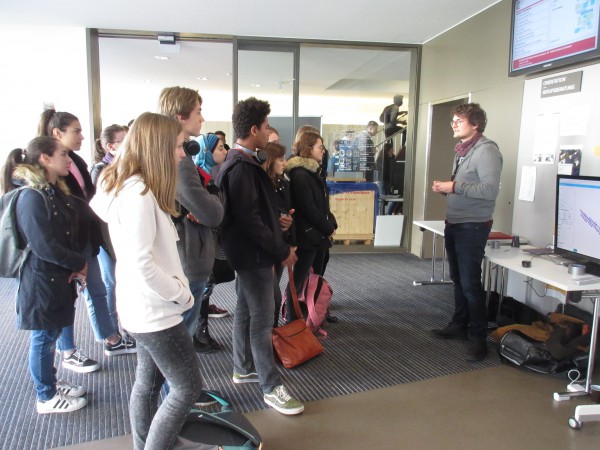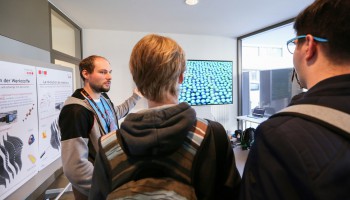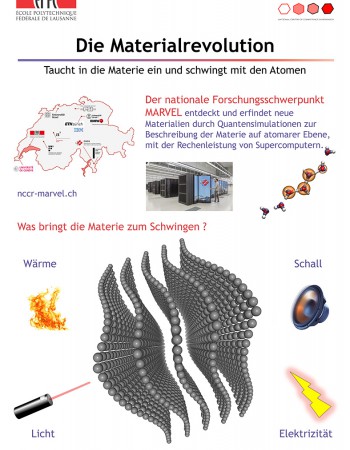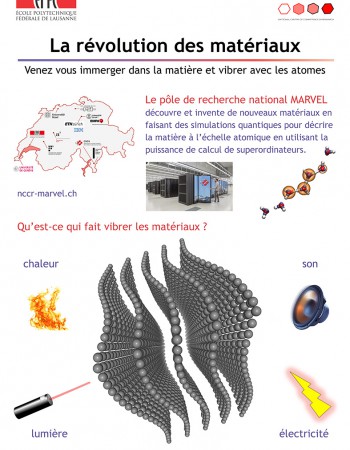Young researchers realize that engaging in outreach activities can be both useful and rewarding
Nathalie Jongen, EPFL, NCCR MARVEL
The 2017 Halloween day was the perfect opportunity for 15-year-old high school students at Collèges Sainte-Croix and Gambach to meet researchers, students and entrepreneurs who shared their motivation and enthusiasm in the hopes of triggering their desire to initiate scientific studies!
Thibault and Rico, together with MARVEL scientific officer Lidia Favre-Quattropani and EPFL student Roman Blum, eagerly enabled their young visitors to immerse themselves inside materials and vibrate with the atoms, thanks to various multimedia tools including short movies displayed on a 3D screen.
The day, orchestrated by EPFL’s Study Programs Promotion Service, and in the framework of MARVEL Education and Training Activities, was an exciting opportunity for the MARVEL representatives to interface with the younger generation. Let’s see what Thibault and Rico have to say about their experience!

© EPFL - Alain Herzog
Thibault had brought different tools to help students hear and visualize how sounds travel through materials: a slinky —a pre-compressed helical spring toy invented in the 1940’s—a guitar string, a tuning fork and a music box. The open-source app “phono website,” developed by Enrique Miranda to visualize phonon vibrational modes, enabled the visitors to really see how the atoms vibrate inside a selection of materials calculated by the EPFL’s research group.
The 3D screen with its short animations seemed to be the perfect means of engaging students. “It’s kind of fun, because you discover in their behavior that they’re increasingly interested, or not…sometimes not,” Thibault declared. “I think that all the presentations we made were pretty well received most of the time. After about five minutes, one or two persons in each group started asking questions. It was even possible to get deeper, more specific questions from students who had good knowledge of this field.” Rico added: “I was able to get a tuba player to understand how the tuba materials would affect the sound made when playing the tuba. He also noticed that he had to push harder to make a higher note. Yes, whenever the students were able to connect to something they know, they started thinking and asking more questions.”


© EPFL - Alain Herzog
Both young researchers appreciate the flexibility that was offered to them to present whatever they felt would be interesting to their audience, bringing all the gear they considered useful to illustrate the science of sounds and phonons. Thibault values his freedom to adapt the demo to the various groups that visited and make it a fun activity for him. “This leads to more interactive and relaxed discussions,” he said. “My favorite moments were when I felt that I had bridged our scientific field with the hobby practiced by a student,” added Rico. “When they were saying: ‘Oh, this is actually something that applies to me,’ I felt that they then had a good sense that this topic is not completely remote from the real world and from themselves,” he said. Thibault added: “Yes, they realize that physics explains stuff around them every day”. “Asking them if they played an instrument was a good way to initiate a conversation,” Rico said.
Rico HäuselmannThe pleasure of making someone interested in what you’re doing, what you’re studying, is quite rewarding!
“If you find it rewarding to excite the interest of others, if this is something you’re interested in, then you should try this!,” insisted Rico, to encourage his colleagues to get involved in outreach activities to the general public. As another piece of advice, he adds that it is more rewarding when displaying something that triggers peoples’ interest, even if they know nothing about your scientific field. Something that they can touch, that they can watch, that moves, and that they can even play with.
“Working on this project was an outreach exercise that included explaining things as simply as possible, plus developing visual tools to show people, and translating research results into something more accessible,” Thibault said to explain the benefits of being involved in such activities. He continued: “I think that participating in such outreach activities is very beneficial, even for my research and for presenting at specialized conferences. I can use again the tools that I have learned to master this in my research activities as well!”
Thibault SohierIn our job, except for the publication of our papers, we don’t have so many rewards. This is one of them!
“If you look at your field of research, with the point of view of explaining it to someone outside of it, you’ll have to look at it from different perspectives. If you want to do a good job, you’ll have to explore viewpoints you didn’t think to explore before, I think it will strengthen your understanding of your own field,” Rico concluded. “I think I learned quite a bit!”
Watch a video on slinkys and soundwaves:
Posters that were displayed on the booth in Fribourg:


Low-volume newsletters, targeted to the scientific and industrial communities.
Subscribe to our newsletter